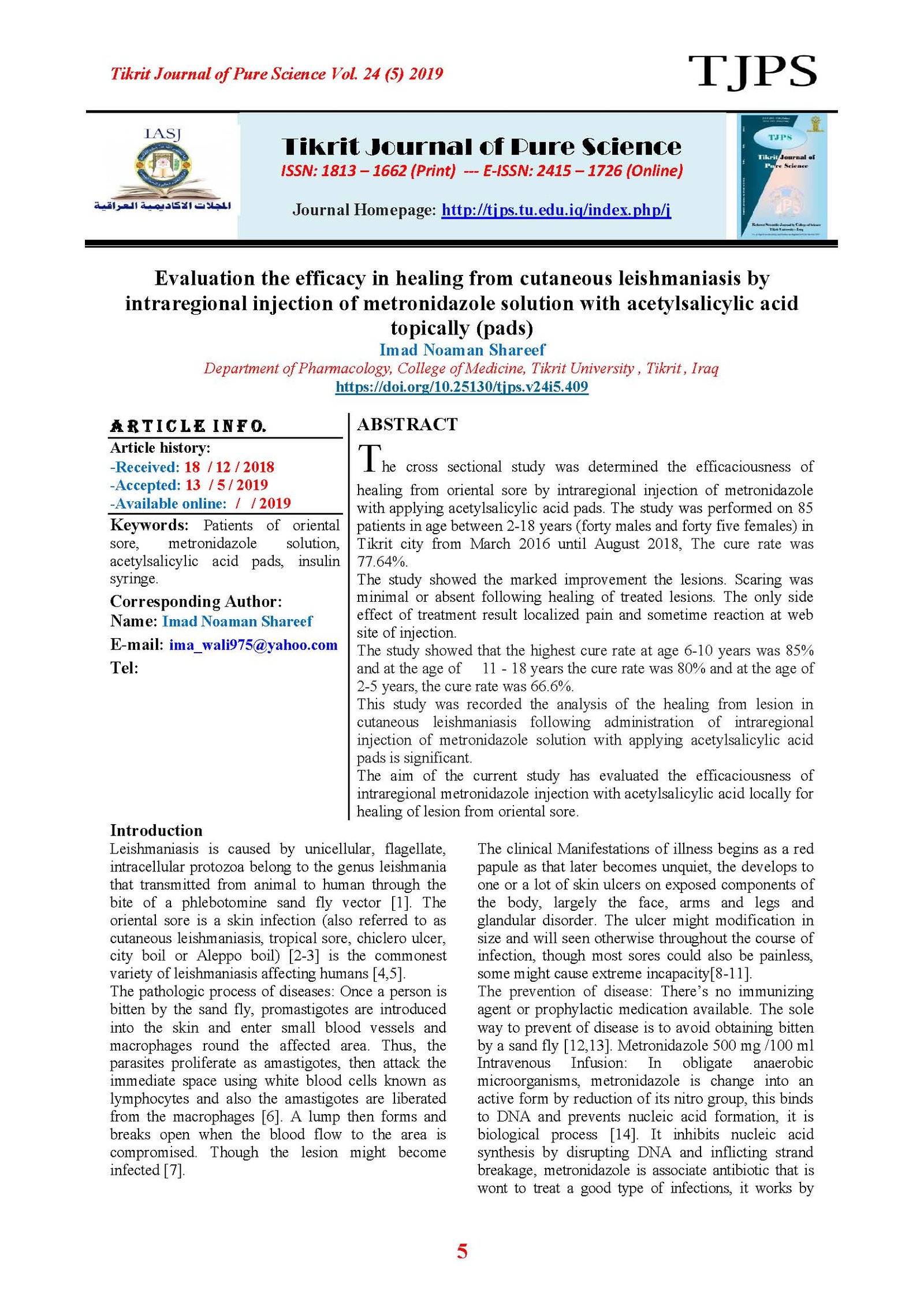Evaluation the efficacy in healing from cutaneous leishmaniasis by intraregional injection of metronidazole solution with acetylsalicylic acid topically (pads)
Main Article Content
Abstract
The cross sectional study was determined the efficaciousness of healing from oriental sore by intraregional injection of metronidazole with applying acetylsalicylic acid pads. The study was performed on 85 patients in age between 2-18 years (forty males and forty five females) in Tikrit city from March 2016 until August 2018, The cure rate was 77.64%.
The study showed the marked improvement the lesions. Scaring was minimal or absent following healing of treated lesions. The only side effect of treatment result localized pain and sometime reaction at web site of injection.
The study showed that the highest cure rate at age 6-10 years was 85% and at the age of 11 - 18 years the cure rate was 80% and at the age of 2-5 years, the cure rate was 66.6%.
This study was recorded the analysis of the healing from lesion in cutaneous leishmaniasis following administration of intraregional injection of metronidazole solution with applying acetylsalicylic acid pads is significant.
The aim of the current study has evaluated the efficaciousness of intraregional metronidazole injection with acetylsalicylic acid locally for healing of lesion from oriental sore.
Article Details

This work is licensed under a Creative Commons Attribution 4.0 International License.
Tikrit Journal of Pure Science is licensed under the Creative Commons Attribution 4.0 International License, which allows users to copy, create extracts, abstracts, and new works from the article, alter and revise the article, and make commercial use of the article (including reuse and/or resale of the article by commercial entities), provided the user gives appropriate credit (with a link to the formal publication through the relevant DOI), provides a link to the license, indicates if changes were made, and the licensor is not represented as endorsing the use made of the work. The authors hold the copyright for their published work on the Tikrit J. Pure Sci. website, while Tikrit J. Pure Sci. is responsible for appreciate citation of their work, which is released under CC-BY-4.0, enabling the unrestricted use, distribution, and reproduction of an article in any medium, provided that the original work is properly cited.
References
[1] Nicki, R. Colledge. (2010). Davidson’s principle and Practice of medicine, (21st eds), (13):356-362.
[2] Calvopiña, M. (2013). "Cutaneous leishmaniasis "chiclero's ulcer" in subtropical Ecuador". American Journal of Tropical Medicine and Hygiene, 89 (2):195–198.
[3] James, William D. and Berger, Timothy G. (2006). Andrews' Diseases of the Skin. Clinical Dermatology. Saunders Elsevier: p. 150-155.
[4] Banerjee, N. (1973) "Role of I.M.A. During natural calamities and national emergencies". Journal of the Indian Medical Association, 61 (11):477–81.
[5] Leon, Gordis. (2004). Epidemiology, (3rd eds), (7):115-130.
[6] Rathi, SK. (2005). "Post-kala-azar dermal leishmaniasis: a histopathological study". Indian journal of dermatology, venereology and leprology, 71 (4):250–3.
[7] Salotra, P and Singh, R. (2006). "Challenges in the diagnosis of post-kala-azar dermal leishmaniasis". Indian J. Med. Res, 123 (3):295–310.
[8] Bailey, MS and Lockwood, DN. (2007). Cutaneous leishmaniasis. Clin Dermatol, 25 (2):203–211.
[9] A Hunter, J.(2002). Clinical dermatology, 16:194-201.
[10] Van, Thiel PP. (2010). Cutaneous leishmaniasis (Leishmania major infection) in Dutch troops deployed in northern Afghanistan: epidemiology, clinical aspects, and treatment. Am J Trop Med Hyg, 83 (6):1295–1300.
[11] Bart, A, et al. (2013). Imported leishmaniasis in The Netherlands from 2005 to 2012: epidemiology, diagnostic techniques and sequence-based species typing from 195 patients. Euro Surveill, 18 (30): 20544.
[12] Saberi, S. (2012). The knowledge, attitude, and prevention practices of students regarding cutaneous leishmaniasis in the hyperendemic region of the Shahid Babaie Airbase. Vector Borne Zoonotic Dis., 12 (4):306–309.
[13] Chaves, LF. (2014). Cutaneous leishmaniasis and sand fly fluctuations are associated with el nino in panama. PLoS Negl Trop Dis, 8 (10):210.
[14] P.N. Bennett and M.J. Brown. (2008). Clinical pharmacology, (10th eds), P. 205-206.
[15] Don, A. Ballington and Mary, M. Laughlin. (2008). Pharmacology, (3rd edition), 4:82.
[16] Seth, S D and Vimlesh, Seth. (2009). Textbook of Pharmacology, 93rd edition), 83:x1.9-10.
[17] Haynes and William, M. (2011). CRC Handbook of Chemistry and Physics (92nd ed.). Boca Raton, FL: CRC Press, 3:306
[18] Schrör, Karsten. (2016). (2ndeds), Acetylsalicylic Acid: p. 9–10.
[19] Lawrence, J R. (2017). "Urinary excretion of salicyluric and salicylic acids by non-vegetarians, vegetarians, and patients taking low dose aspirin". Journal of Clinical Pathology. (28 May 2017), 56 (9):651–653.
[20] Jeffreys and Diarmuid . (2005). Aspirin: the remarkable story of a wonder drug. New York: Bloomsbury: p. 38–40.
[21] WHO. (2007). Cutaneous leishmaniasis. Informal Consultative Meeting for the Control of Cutaneous Leishmaniasis in the Middle East and Maghreb, Geneva, on 30 April- 2 May 2007.
[22] Rastogi, V and Nirwan, PS. (2007). Cutaneous leishmaniasis: An emerging infection in a non-endemic area and a brief update, 25:272-5.
[23] Molavi A. (1982). Metronidazole. Med Clin North Am, 66:121-33.
[24] Long, PI. (1973). Cutaneous leishmaniasis treated with metronidazole. JAMA, 223:1378-9.
[25] Pedersen, JK and Sawicki, S. (1975). Metronidazole therapy for cutaneous leishmaniasis. Arch Dermatol, 111:1343-4.
[26] Jundishapur Journal of Microbiology. 2010; 3(2):79-83.
[27] Al-Waiz, M. (2004). Treatment of cutaneous leishmaniasis by intralesional metronidazole. Saudi Med J, 25 (10):1512-3.
